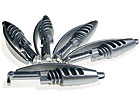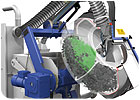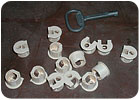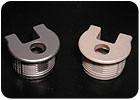
These plastic parts were coated in the tumble spraying system.
The competitive pressures from overseas markets make generating a profit extremely tough for U.S. manufacturers. Manufacturers of plastic parts that need to be coated face a particularly difficult challenge. Conventional finishing methods such as hanging small parts on racks that must go through a large paint system or robotically spraying individual parts often require people to handle each part before and after it is coated, which increases labor costs. Additionally, while coating material costs are relatively low, the large amount of waste from overspray increases the amount of coating required to complete the finishing process and can dramatically reduce profitability.
Recently, a new tumble spraying system* was developed to eliminate these parts coating issues and help manufacturers of plastic products regain their competitive edge.

Figure 1. The system works by heating and tumbling small parts in an elliptical-shaped barrel beneath a spray nozzle or nozzles.
Tumble Spraying Basics
The new system works by tumbling small parts in an elliptical-shaped barrel beneath a spray nozzle or nozzles (see Figure 1). Heated, prefiltered forced air is injected into the spray zone to help the coating adhere to the parts. Since parts will tumble differently in the barrel depending on their geometry and weight, the inclination of the barrel can be adjusted from 0 to 35 degrees to “customize” the coating angle for each batch of parts and further optimize the coating application. The barrel also can rotate 125 degrees in either direction to allow for easy part loading and unloading. The barrel can run anywhere from 2-30 rpm, and the processing temperature can range from ambient to 300°F, depending on the parts and the finish being applied.An exhaust fan with a post filter allows negative pressure to be maintained in the spray area where the parts are being coated. A Fanuc PLC controller monitors every aspect of the coating process and immediately notifies the operator if any deviations occur so that no off-spec parts are produced. The use of an elliptical-shaped barrel, rather than a conventional octagon, prevents parts from riding only along the outside edge of the barrel and ensures even paint coverage on all areas of the parts. When the process is complete, the barrel is tilted to unload the completely dry parts, which then can be placed directly into a shipping container or moved to an assembly area for further processing.

Figure 2. More than 4,000 7⁄8 x 1 x 9∕16-in.-thick uncoated plastic parts were loaded into the barrel of a tumble spraying machine for finishing.
Efficient Fixture Finishing
One application for this technology is in coating plastic furniture parts. In a conventional coating process, the parts would be hung on a rack and sprayed. A substantial amount of labor is required to hang the parts on hooks, and as much as 70% overspray can occur during the finishing process.
Figure 3. A finished part is shown on the left.
Some companies in Europe have already begun to embrace this new technology for coating furniture and home furnishing components. One goal in these industries is to produce inexpensive plastic door handles and fixtures that are coated to look like high-end shiny aluminum. Several manufacturers had originally invested several million dollars in a robotic coating operation that picked up and sprayed each drawer handle individually so that all areas of the parts were coated with no touch marks, smearing of the coating or orange peel defects. These companies were using a very expensive paint to achieve the required “mirror aluminum” look, but most of the coating was being lost through overspray.

Figure 4. An example of a processed coat hook (bottom) with a mirror aluminum finish.
Toys and Other Applications
The coating used in the tumble spraying system can be solvent- or water-based (or epoxy-lacquer based for metal parts). The system also can be used to coat one part with two different materials in one process in order to achieve the desired finish. For example, one manufacturer needed an “antique” finish on a small plastic toy. The tumble spraying system was set up to use two pressure vessels and two nozzles for this application. The uncoated toy shields enter the machine, and a very specific amount of one coating is applied through one nozzle, followed by a drying cycle. A specific amount of a second coating is then applied through the other nozzle to create the required antique look. As soon as the coating process is finished, the parts are ready to packed and shipped. They only need to be touched twice - once to be loaded into the machine, and the second time when they are unloaded and packed into a box.There are some restrictions on what types of plastic material can be coated - for example, most crystalline plastics will need plasma pretreatment to etch the surface prior to coating. However, plastic parts made from acrylonitrile butadiene styrene (ABS), polycarbonate and polystyrene can be coated easily in the tumble spraying system. The machine also has been used successfully outside of the plastics industry for the decorative coating of metal parts, applying colored slide coatings to rubber “O” rings for easier assembly and identification, and finishing metal parts with anti-corrosion coatings.
As manufacturers search for ways to lower labor costs and reduce waste in their finishing operations, new finishing alternatives such as tumble spraying provide an attractive solution.
For more information, visit www.walther-trowal.com.
*Rotamat Small Parts Coating System, available from Walther Trowal, Haan, Germany and Grand Rapids, MI

Report Abusive Comment